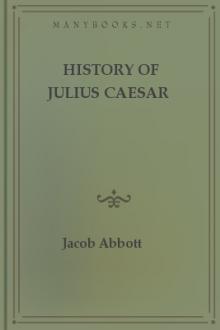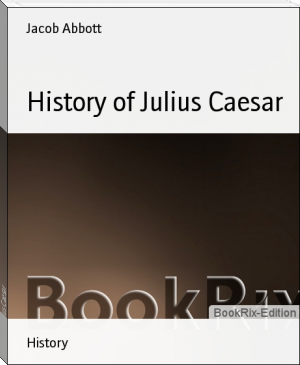Cleopatra by Jacob Abbott (best fiction novels to read TXT) 📕

- Author: Jacob Abbott
- Performer: -
Book online «Cleopatra by Jacob Abbott (best fiction novels to read TXT) 📕». Author Jacob Abbott
The produce of the valley was thus brought down the river and through the canal to the city. Here immense warehouses and granaries were erected for its reception, that it might be safely preserved until the ships that came into the port were ready to take it away. These ships came from Syria, from all the coasts of Asia Minor, from Greece, and from Rome. They brought the agricultural productions of their own countries, as well as articles of manufacture of various kinds; these they sold to the merchants of Alexandria, and purchased the productions of Egypt in return.
The port of Alexandria presented thus a constant picture of life and animation. Merchant ships were continually coming and going, or lying at anchor in the roadstead. Seamen were hoisting sails, or raising anchors, or rowing their capacious galleys through the water, singing, as they pulled, to the motion of the oars. Within the city there was the same ceaseless activity. Here groups of men were unloading the canal boats which had arrived from the river. There porters were transporting bales of merchandise or sacks of grain from a warehouse to a pier, or from one landing to another. The occasional parading of the king's guards, or the arrival and departure of ships of war to land or to take away bodies of armed men, were occurrences that sometimes intervened to interrupt, or as perhaps the people then would have said, to adorn this scene of useful industry; and now and then, for a brief period, these peaceful vocations would be wholly suspended and set aside by a revolt or by a civil war, waged by rival brothers against each other, or instigated by the conflicting claims of a mother and son. These interruptions, however, were comparatively few, and, in ordinary cases, not of long continuance. It was for the interest of all branches of the royal line to do as little injury as possible to the commercial and agricultural operations of the realm. In fact, it was on the prosperity of those operations that the revenues depended. The rulers were well aware of this, and so, however implacably two rival princes may have hated one another, and however desperately each party may have struggled to destroy all active combatants whom they should find in arms against them, they were both under every possible inducement to spare the private property and the lives of the peaceful population. This population, in fact, engaged thus in profitable industry, constituted, with the avails of their labors, the very estate for which the combatants were contending.
Seeing the subject in this light, the Egyptian sovereigns, especially Alexander and the earlier Ptolemies, made every effort in their power to promote the commercial greatness of Alexandria. They built palaces, it is true, but they also built warehouses.
One of the most expensive and celebrated of all the edifices that they reared was the light-house which has been already alluded to. This light-house was a lofty tower, built of white marble. It was situated upon the island of Pharos, opposite to the city, and at some distance from it. There was a sort of isthmus of shoals and sand-bars connecting the island with the shore. Over these shallows a pier or causeway was built, which finally became a broad and inhabited neck. The principal part of the ancient city, however, was on the main land.
The curvature of the earth requires that a light-house on a coast should have a considerable elevation, otherwise its summit would not appear above the horizon, unless the mariner were very near. To attain this elevation, the architects usually take advantage of some hill or cliff, or rocky eminence near the shore. There was, however, no opportunity to do this at Pharos; for the island was, like the main land, level and low. The requisite elevation could only be attained, therefore, by the masonry of an edifice, and the blocks of marble necessary for the work had to be brought from a great distance. The Alexandrian light-house was reared in the time of Ptolemy Philadelphus, the second monarch in the line. No pains or expense were spared in its construction. The edifice, when completed, was considered one of the seven wonders of the world. It was indebted for its fame, however, in some degree, undoubtedly to the conspicuousness of its situation, rising, as it did, at the entrance of the greatest commercial emporium of its time, and standing there, like a pillar of cloud by day and of fire by night, to attract the welcome gaze of every wandering mariner whose ship came within its horizon, and to awaken his gratitude by tendering him its guidance and dispelling his fears.
The light at the top of the tower was produced by a fire, made of such combustibles as would emit the brightest flame. This fire burned slowly through the day, and then was kindled up anew when the sun went down, and was continually replenished through the night with fresh supplies of fuel. In modern times, a much more convenient and economical mode is adopted to produce the requisite illumination. A great blazing lamp burns brilliantly in the center of the lantern of the tower, and all that part of the radiation from the flame which would naturally have beamed upward, or downward, or laterally, or back toward the land, is so turned by a curious system of reflectors and polyzonal lenses, most ingeniously contrived and very exactly adjusted, as to be thrown forward in one broad and thin, but brilliant sheet of light, which shoots out where its radiance is needed, over the surface of the sea. Before these inventions were perfected, far the largest portion of the light emitted by the illumination of light-house towers streamed away wastefully in landward directions, or was lost among the stars.
Of course, the glory of erecting such an edifice as the Pharos of Alexandria, and of maintaining it in the performance of its functions, was very great; the question might, however, very naturally arise whether this glory was justly due to the architect through whose scientific skill the work was actually accomplished, or to the monarch by whose power and resources the architect was sustained. The name of the architect was Sostratus. He was a Greek. The monarch was, as has already been stated, the second Ptolemy, called commonly Ptolemy Philadelphus. Ptolemy ordered that, in completing the tower, a marble tablet should be built into the wall, at a suitable place near the summit, and that a proper inscription should be carved upon it, with his name as the builder of the edifice conspicuous thereon. Sostratus preferred inserting his own name. He accordingly made the tablet and set it in its place. He cut the inscription upon the face of it, in Greek characters, with his own name as the author of the work. He did this secretly, and then covered the face of the tablet with an artificial composition, made with lime, to imitate the natural surface of the stone. On this outer surface he cut a new inscription, in which he inserted the name of the king. In process of time the lime moldered away, the king's inscription disappeared, and his own, which thenceforward continued as long as the building endured, came out to view.
The Pharos was said to have been four hundred feet high. It was famed throughout the world for many centuries; nothing, however, remains of it now but a heap of useless and unmeaning ruins.
Besides the light that beamed from the summit of this lofty tower, there was another center of radiance and illumination in ancient Alexandria, which was in some respects still more conspicuous and renowned, namely, an immense library and museum established and maintained by the Ptolemies. The Museum, which was first established, was not, as its name might now imply, a collection of curiosities, but an institution of learning, consisting of a body of learned men, who devoted their time to philosophical and scientific pursuits. The institution was richly endowed, and magnificent buildings were erected for its use. The king who established it began immediately to make a collection of books for the use of the members of the institution. This was attended with great expense, as every book that was added to the collection required to be transcribed with a pen on parchment or papyrus with infinite labor and care. Great numbers of scribes were constantly employed upon this work at the Museum. The kings who were most interested in forming this library would seize the books that were possessed by individual scholars, or that were deposited in the various cities of their dominions, and then, causing beautiful copies of them to be made by the scribes of the Museum, they would retain the originals for the great Alexandrian library, and give the copies to the men or the cities that had been thus despoiled. In the same manner they would borrow, as they called it, from all travelers who visited Egypt, any valuable books which they might have in their possession, and, retaining the originals, give them back copies instead.
In process of time the library increased to four hundred thousand volumes. There was then no longer any room in the buildings of the Museum for further additions. There was, however, in another part of the city, a great temple called the Serapion. This temple was a very magnificent edifice, or, rather, group of edifices, dedicated to the god Serapis. The origin and history of this temple were very remarkable. The legend was this:
It seems that one of the ancient and long-venerated gods of the Egyptians was a deity named Serapis. He had been, among other divinities, the object of Egyptian adoration ages before Alexandria was built or the Ptolemies reigned. There was also, by a curious coincidence, a statue of the same name at a great commercial town named Sinope, which was built upon the extremity of a promontory which projected from Asia Minor into the Euxine Sea. Sinope was, in some sense, the Alexandria of the north, being the center and seat of a great portion of the commerce of that quarter of the world.
The Serapis of Sinope was considered as the protecting deity of seamen, and the navigators who came and went to and from the city made sacrifices to him, and offered him oblations and prayers, believing that they were, in a great measure, dependent upon some mysterious and inscrutable power which he exercised for their safety in storms. They carried the knowledge of his name, and tales of his imaginary interpositions, to all the places that they visited; and thus the fame of the god became extended, first, to all the coasts of the Euxine Sea, and subsequently to distant provinces and kingdoms. The Serapis of Sinope began to be considered every where as the tutelar god of seamen.
Accordingly, when the first of the Ptolemies was forming his various plans for adorning and aggrandizing Alexandria, he received, he said, one night, a divine intimation in a dream that he was to obtain the statue of Serapis from Sinope, and set it up in Alexandria, in a suitable temple which he was in the mean time to erect in honor of the god. It is obvious that very great advantages to the city would result from the accomplishment of this design. In the first place, a temple to the god Serapis would be a new distinction for it in the minds of the rural population, who would undoubtedly suppose that the deity honored by it was their own ancient god. Then the whole maritime and nautical interest of the world, which had been, accustomed to adore the god of Sinope, would turn to Alexandria as the great center of religious attraction, if their venerated idol could be carried and placed in a new and magnificent temple built expressly for him there. Alexandria could never be the chief naval port and station of the world, unless it contained the sanctuary and shrine of the god of seamen.
Ptolemy sent accordingly to the King of Sinope and proposed to purchase the idol. The embassage was, however, unsuccessful. The king refused to give up the god. The negotiations were continued for two years, but all in vain. At length, on account of some failure in the regular course of the seasons on that coast, there was a famine there, which became finally so severe that the people of the city were induced to consent to give up their deity to the Egyptians in exchange for a supply of corn. Ptolemy sent





Comments (0)